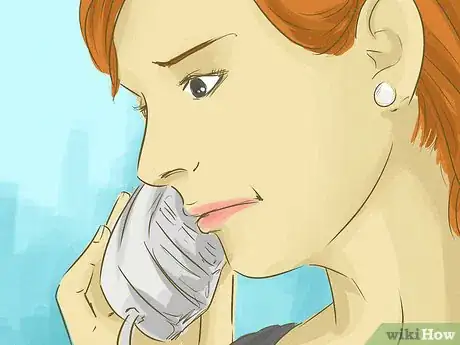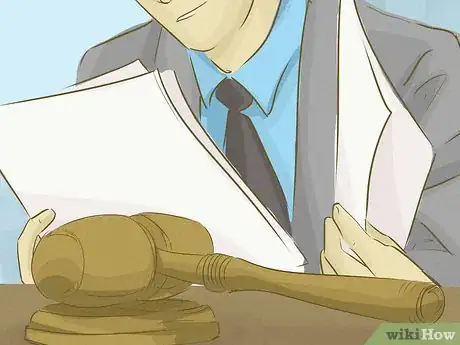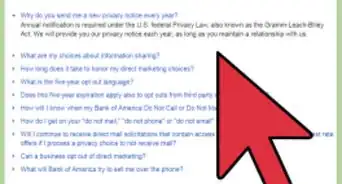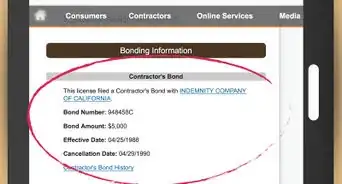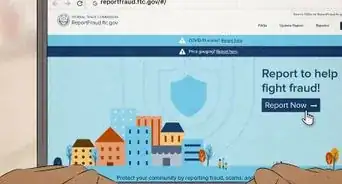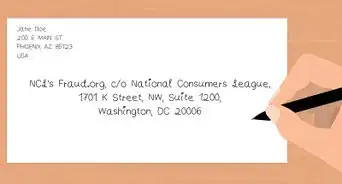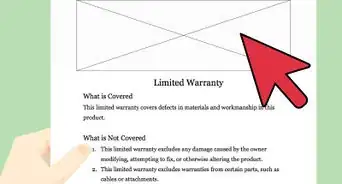This article was co-authored by Clinton M. Sandvick, JD, PhD. Clinton M. Sandvick worked as a civil litigator in California for over 7 years. He received his JD from the University of Wisconsin-Madison in 1998 and his PhD in American History from the University of Oregon in 2013.
There are 12 references cited in this article, which can be found at the bottom of the page.
This article has been viewed 55,227 times.
If you believe a company is advertising something that is not true, there is something you can do. You can complain to the appropriate agencies, sue them for false advertising, or you can do both of those. This article will briefly explain how. Some of the specifics will be different from one state to the next.
Steps
Understanding False Advertising
-
1Know the definition of false advertising. False advertising is any advertisement by a store that is likely to mislead the consumer. Each state and the federal government has its own laws about false advertising, but in most cases:[1]
- An advertisement does not have to be intentionally misleading to be false advertising.
- An advertisement does not have to actually mislead anyone to be false advertising.
- An advertisement can be technically true and still be false advertising if the overall circumstances are potentially misleading.
-
2Recognize common false advertising practices. Some common false advertising schemes include:[2]
- Offering something free with the purchase of another item, but raising the price of the other product to compensate
- Stating a regular price that has only been briefly (or never) used in the past
- Stating that you will provide a service, and then providing less than what was promised
- Stating that a product is or does something that is inaccurate
Advertisement -
3Ask an agency or attorney if you are unsure. If you are unsure whether an advertisement or business practice is false advertising, you can ask various agencies, such as:
- The Better Business Bureau (BBB)
- The US Federal Trade Commission (FTC)
- Your local consumer affairs agency
- An attorney
Complaining to Appropriate Agencies
-
1Contact the US Federal Trade Commission. Contact the US Federal Trade Commission (FTC) online at https://www.ftccomplaintassistant.gov/#crnt&panel1-1. The FTC can investigate your complaint and take the following actions:[3]
- Require the advertiser to cease the deceptive advertising
- Bring a civil lawsuit (usually class action) on behalf of people harmed
- Require the advertiser to correct the deceptive practice by running an advertisement admitting the earlier ad was misleading
-
2Call your local Better Business Bureau. Locate your local Better Business Bureau at https://www.bbb.org/. The BBB was established to encourage businesses to deal fairly with their customers and provide the customer with an avenue for support when they were wronged. Some things the BBB does include:[4]
- Assists in resolving disputes between business and consumers
- Provides education to businesses and consumers on proper practices
- Provides a rating system of businesses that consumers can check to view complaints that other consumers have made against a business.
-
3Complain to your local consumer affairs agency. Most states have a consumer affairs agency similar to the US FTC.[5]
- Search for “consumer affairs” and “[yourstate]” to locate the website and contact information of the agency.
- Call the number provided or navigate to an online complaint system on their website.
- Follow their instructions and listen to what the state agency can do for you.
Preparing Your Case
-
1Consider hiring an attorney. Consumer protection law is very detailed and fact specific. A local attorney should be familiar with the laws in your area and how they are applied in your court system. Even if you choose to not use an attorney for full representation, it may be beneficial to pay for “unbundled services”, which are limited to simply providing for your needs. These services include:
- Preparing documents
- Giving legal advice
- Teaching you the law as it applies to your case
-
2Decide between your own case or a class action suit. A class action suit is one in which one or two named plaintiffs sue the advertiser on behalf of themselves and other people who likely have been harmed (others similarly situated). Often, the named plaintiff receives a higher settlement amount than the other members of the class. Some special rules about class actions suits include:[6]
- You must have an attorney to file a class action suit
- The attorney must be approved by the court as having enough experience to reasonably represent the general members of the class.
- When you participate in a class action suit, you give up the right to sue individually and vice versa.
-
3Locate your court. If you are filling in federal court under the federal laws, you will file in the US District Court in which the advertiser is located. If your state laws offer you better options and you choose to sue under state law, find the website of your state’s court system. Most of them have a link to a description of the courts. Locate the court of general jurisdiction in your state. Determine if there is a court that handles the dollar amount for which you are suing, then find the court of the same name in the county or parish in which your employer is located.
-
4Prepare your documents. There are not likely any pre-prepared forms false advertising, so you will need to ensure you have all of the documents you need. Do a search on similar documents from other cases in your court for examples of these documents. This will be different depending on your jurisdiction, but at a minimum should include:
- Petition or complaint: This document describes the ad, explains how it was misleading, and states why you should be granted the relief you ask for. Be sure to address everything you need to prove in the petition
- Summons or citation: This document orders the employer to answer your petition in court. Frequently, you must prepare it, but the clerk signs it
- After signing, make enough copies that you have the original for the clerk, a copy for you, and a copy for the advertiser
Filing and Serving your case
-
1File your documents. Go to the clerk of either the US District Court or your appropriate state court.[7]
- Give the clerk the original documents (the petition or complaint and summons and any other documents required by your particular court).
- Ask the clerk to sign your summons or citation
- Notate your case number (assigned by the clerk)
- Pay any filing fee. This fee will vary depending on your court.
- Ask the clerk to date stamp your copies
-
2Serve the advertiser. After the clerk issues your summons or citation, you will need to serve the advertiser. Check the appropriate civil procedural rules for proper methods and deadlines for service. The advertiser must usually be served within 90 to 120 days of the filing date. Common methods of service include: [8]
- Pay a private process server to serve them
- Pay the sheriff to serve them
- Hire a person over 18 who is not a party to the case serve them
- Whoever serves the advertiser will need to complete and file or return the appropriate proof of service document
-
3Wait for an answer. In most cases, the advertiser will have to answer your petition within 21 or 30 days.
- Ask the clerk for a copy of the answer if you do not receive one
- If the advertiser files a motion to dismiss and you are not represented, contact an attorney for assistance based on your particular case
Managing Your Case
-
1Read the rules of evidence. To win your case, you must present evidence that the judge or jury can review. Without evidence, you cannot prove there was any false advertising. To learn how to do that, read your jurisdiction’s rules of evidence. If you don’t understand them, contact an attorney for assistance. In those rules, you will learn:[9]
- What evidence can be admitted into court
- What must be proven about the evidence before it can be admitted
- What types of witnesses you can call
- How you can question different kinds of witnesses
-
2Participate in discovery. Discovery is one way that you gather evidence to present. You can use discovery methods to obtain information and things that may lead to admissible evidence you use to prove the false advertising. The discovery tools include:
- Interrogatories: Usually written questions that must be answered under oath
- Depositions: Usually oral questioning of a party or potential witness under oath
- Requests for production: Lists of documents and other items that the other party or third person must provide you, either a copy or the ability to inspect the original item
- Requests for admission: Requests to the other party that they admit certain facts, relieving you of the requirement to prove that particular fact
-
3Participate in mediation. Most courts require all cases to make an attempt at settlement. If your false advertising case is sent to mediation, a neutral third person will attempt to negotiate a settlement between you and the advertiser.< ref> http://dictionary.law.com/Default.aspx?selected=1233</ref>
- If mediation is successful, the mediator will prepare any documents necessary for the judge to sign, and your agreement will become the order of the court.
- If mediation is not successful, you will continue to court to prove your allegations of false advertising.
-
4Schedule your hearing. Once discovery is complete and attempts at settlement have failed, you will need to schedule your hearing. Contact the clerk of the court in which you filed your papers to learn the local procedure to do this. Once the hearing is scheduled, you will need to inform the advertiser information regarding the hearing. That information may be sent on a form or just a letter, but it must include: [10]
- The date of the hearing
- The time of the hearing
- The location of the hearing
- The name of the judge or magistrate who will conduct the hearing
- The length of time the hearing is expected to take
-
5Attend your hearing. The hearing is your opportunity to present evidence of the false advertising to the court. It is also the advertiser’s opportunity to present evidence showing the advertisement was not false. Your hearing will likely progress something like this:[11]
- You will make your opening statements, explaining to the court what you are going to prove
- The advertiser will make their opening statements, explaining to the court how they are going to show the advertisement was not misleading
- You will call and question your witnesses and present your evidence.
- The advertiser will question your witnesses after you have questioned them first
- The advertiser will call and question their witnesses and present their evidence
- You will question their witnesses after the advertiser has questioned them first
- You will give your closing statements, summarizing the evidence and explaining why the law supports a ruling in your favor
- The advertiser will give their closing statements, summarizing the evidence and explaining why the law supports a ruling not in your favor
- You have an opportunity to rebut the advertiser’s closing statements, if you choose to do so
- The judge or jury will give the ruling or verdict
-
6Prepare the order. In most cases, the prevailing party is tasked with preparing the order. If the advertiser is represented by an attorney and you are not, the advertiser’s attorney may be tasked with this even if you prevail. If you are tasked with preparing the order:[12]
- Copy the heading and format from previous documents in the case, especially a prior order
- State the date the hearing occurred, the issues that were argued, and the ruling that was made
- Insert the judge’s signature block. You can copy it from prior orders or obtain it from the clerk
- Make three copies
- File the original with the clerk
- Mail a copy to the advertiser or their attorney
- Keep a copy for your records
- Ask the clerk when a copy of the signed order will be ready for you to pick up
References
- ↑ http://www.nolo.com/legal-encyclopedia/consumer-protection-laws-business-29641.html
- ↑ http://www.businessinsider.com/false-advertising-scandals-2011-9?op=1
- ↑ https://www.ftc.gov/
- ↑ http://www.bbb.org/council/
- ↑ http://www.myfloridacfo.com/division/consumers/
- ↑ https://www.law.cornell.edu/wex/class_action
- ↑ https://www.law.cornell.edu/rules/frcp/rule_3
- ↑ http://legal-dictionary.thefreedictionary.com/Service+of+Process
- ↑ http://kslegislature.org/li_2014/b2013_14/statute/060_000_0000_chapter/060_004_0000_article/



-Step-1.webp)
